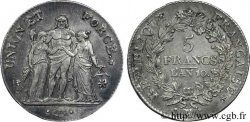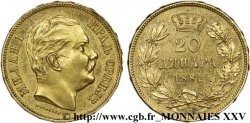v24_1910 - 5 francs Union et Force, Union serré, avec glands intérieurs et gland extérieur 1802 Marseille F.288/182
MONNAIES 24 (2005)
起拍价 : 1 500.00 €
估价 : 3 000.00 €
竞价记录 : 1 915.00 €
出价数量 : 5
最高出价 : 1 961.00 €
起拍价 : 1 500.00 €
估价 : 3 000.00 €
竞价记录 : 1 915.00 €
出价数量 : 5
最高出价 : 1 961.00 €
种类 5 francs Union et Force, Union serré, avec glands intérieurs et gland extérieur
日期: An 10 (1801-1802)
铸币厂名称/城市 Marseille
铸币数量 39266
材质 silver
纯度、成色(用角密度) 900 ‰
直径 36 mm
模子方针 6 h.
重量 24,79 g.
侧面 décorée en creux : GARANTIE NATIONALE
稀少度 R1
关于品相的说明
Exemplaire superbe ayant conservé l’essentiel de son brillant de frappe sous une jolie patine de médaillier. Exemplaire présentant d’infimes “hair lines” ainsi que les traces d’un petit choc sous le T de ET, deux fines rayures sous l’Artémis et deux petites dépressions sur la fin du mot RÉPUBLIQUE
家谱
Cet exemplaire provient de la Collection M.L.F.A.
正面
正面的文字 UNION ET FORCE.*.
正面的说明书 Hercule barbu demi-nu, debout de face avec la léonté, sur son épaule gauche une patte du lion, sur son bras et autour de sa taille la peau du lion de Némée, derrière ses jambes queue et pattes du lion, unissant la Liberté debout à gauche tournée à droite tenant une pique surmontée d'un bonnet phrygien, vêtue d'un peplos, et l'Égalité debout à droite tournée à gauche, tenant le niveau, vêtue d'un chiton ; à l'exergue Dupré signé en cursif entre deux points, légende serrée.
背面
背面的文字 RÉPUBLIQUE FRANÇAISE*.
背面的说明书 5 / FRANCS., en deux lignes ; au-dessous un trait séparatif et L'AN 10 . , le tout contenu dans une couronne composée à gauche d'une branche de laurier, à droite d'une branche de chêne avec grande feuille finale (deux glands intérieurs sur le haut de la branche de droite, un gland à l'extérieur sur le bas de cette branche), nouées à leur base par un ruban ; au-dessous la lettre d'atelier MA entre deux points.
评论
Rare variété avec le différent aux pointes à 1, 3, 5, 7, 9 et 11 heures comme l’exemplaire de la vente Kolsky, différent qualifié de “sceau de Salomon”. Dans le FRANC V, le différent “molette” avec les pointes à 12, 2, 4, 6, 8 et 10 heures est indiqué. C’est le nouvel exemplaire de la Collection Idéale.








 对产品描述纠错
对产品描述纠错 打印
打印 分享我的选择
分享我的选择 提问
提问 Consign / sell
Consign / sell
 产品介绍
产品介绍















